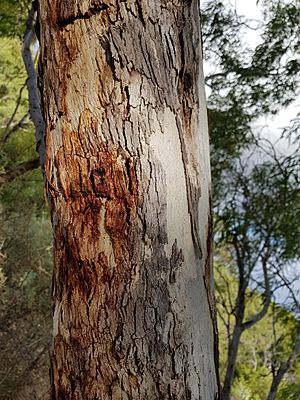Smooth-barked coolibah facts for kids
Quick facts for kids Smooth-barked coolibah |
|
|---|---|
 |
|
| Eucalyptus victrix habit | |
| Scientific classification | |
| Genus: |
Eucalyptus
|
| Species: |
victrix
|
 |
|
| Occurrence data from Australasian Virtual Herbarium | |
The smooth-barked coolibah (Eucalyptus victrix) is a unique tree found only in Australia. People also call it the western coolibah or little ghost gum. It has smooth bark and leaves shaped like a spear. Its flowers are creamy white, and its fruit looks like a small cone.
Contents
What Does It Look Like?
The smooth-barked coolibah is a tree that spreads out. It usually grows between 1 and 12 meters tall. Sometimes, it can even reach up to 22 meters! This tree has a special woody swelling at its base called a lignotuber. This helps it regrow after fires.
Its bark is mostly smooth. But at the bottom, up to about 1 meter high, it often has rougher bark. Young plants have wide, spear-shaped leaves. These leaves are about 8 to 12.5 centimeters long.
Adult leaves are green on both sides. They are also spear-shaped, but sometimes a bit curved. They grow to be 9 to 15 centimeters long. These leaves narrow down to a stalk called a petiole, which is 7 to 23 millimeters long.
The tree's flower buds grow in groups of seven. They are found at the ends of the branches. Each group of buds sits on a small stalk, 1 to 2 millimeters long. The individual buds are oval-shaped. They are 3 to 5 millimeters long and 2 to 3 millimeters wide. Each bud has a cap called an operculum.
This tree blooms between November and March. Its flowers are a lovely creamy white color. After flowering, the tree produces a woody, cone-shaped fruit. This fruit is a capsule, about 2 to 5 millimeters long.
How It Got Its Name
Eucalyptus victrix was first officially described in 1994. Two scientists, Lawrie Johnson and Ken Hill, gave it its name. They wrote about it in a science journal called Telopea.
The second part of its name, victrix, comes from a Latin word. It means "victor" or "winner." This name was chosen because the tree does very well in tough, dry climates. It's a real survivor!
Where Does It Grow?
The smooth-barked coolibah is found in several parts of Australia. You can see it in Western Australia, especially in the Mid West, Pilbara, Kimberley, and Goldfields-Esperance regions. It likes to grow on flat areas and flood plains. It prefers sandy, loamy, or clay soils.
This tree also grows across most of the Northern Territory. You can find it in the far western part of Queensland too.
How People Use This Tree
Traditional Uses
For a very long time, Aboriginal peoples have used the coolibah tree in many ways. They used it for food and water. They also made weapons and tools from its wood. The tree provided firewood, shade, and shelter. It was also important for their cultural practices.
Different Aboriginal groups have their own names for this tree. The Arrernte people call it ankerre. The Jaru people know it as gurndad. And the Pitjantjatjara people call it ankara.
Growing It in Gardens
The smooth-barked coolibah is not a common garden plant. However, it can be a beautiful addition to a garden. It grows well in full sunlight. It also likes most types of soil, as long as the water drains away easily.
You usually don't need to prune this tree. You might only trim it to give it a nice shape. You can grow new trees from its seeds. This tree is also strong against most plant diseases and pests. It can handle dry weather and strong winds very well.


